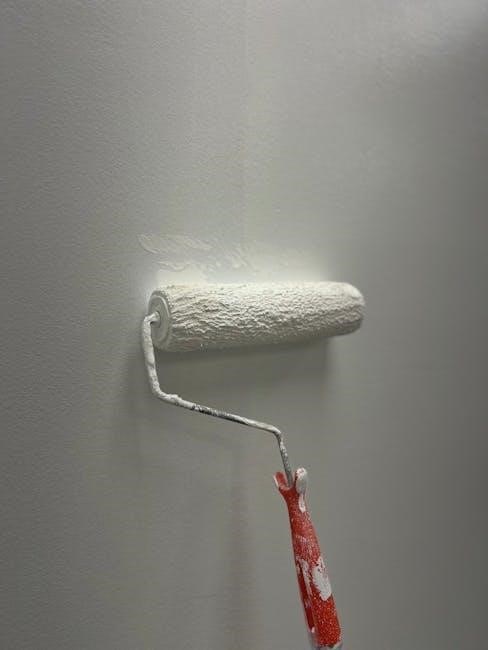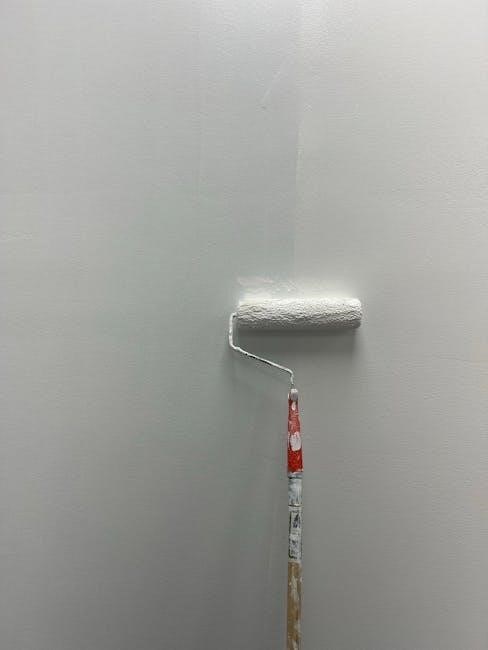Cable guide rollers are essential components designed to manage and organize cables efficiently, ensuring smooth operation and preventing damage in various systems and applications.
1.1 Overview of Cable Guide Rollers
Cable guide rollers are cylindrical or oval-shaped components designed to support and direct cables in various systems. They are typically mounted on frames or surfaces to ensure cables move smoothly without tangling or twisting. These rollers often feature grooved surfaces to securely hold cables in place and may include bearings to reduce friction during movement. Available in different sizes and materials, they are versatile for use in industrial, commercial, and residential settings. Their primary function is to guide cables along predefined paths, preventing damage and ensuring reliable operation. By providing a stable and controlled environment for cable movement, guide rollers play a crucial role in maintaining system efficiency and longevity.
1.2 Importance of Cable Guide Rollers in Modern Systems
Cable guide rollers are indispensable in modern systems due to their role in preventing cable damage, reducing wear and tear, and ensuring smooth operation. They minimize friction, which prolongs cable lifespan and maintains signal integrity. In industrial settings, these rollers are critical for heavy-duty applications, where cable durability is paramount. They also enhance safety by keeping cables organized, reducing the risk of tripping hazards and electrical issues. Additionally, cable guide rollers contribute to system reliability by maintaining consistent cable positioning, especially in dynamic environments. Their importance extends to various industries, including robotics, automation, and telecommunications, where precise cable management is essential for optimal performance and efficiency.

Design and Construction of Cable Guide Rollers
Cable guide rollers are meticulously engineered for durability and functionality, ensuring smooth cable movement and long-lasting performance in various applications and environments.
2.1 Materials Used in Manufacturing Cable Guide Rollers
Cable guide rollers are typically made from durable materials such as steel, aluminum, or high-performance polymers, ensuring strength and resistance to wear. Stainless steel is often used for corrosion resistance, while nylon or polyurethane offers flexibility and smooth cable movement. In heavy-duty applications, composite materials may be employed to combine strength with lightweight properties. The choice of material depends on the intended use, environmental factors, and required load capacity. High-quality materials ensure longevity and reliable performance, making cable guide rollers suitable for industrial, commercial, and residential settings. Proper material selection is critical to meet specific application demands and ensure optimal functionality.
2.2 Key Components of a Cable Guide Roller
A cable guide roller typically consists of a few essential components that ensure its functionality. The roller body is the main structure, usually cylindrical, designed to allow cables to move smoothly over its surface. Bearings are integrated to reduce friction and enable effortless rotation, enhancing durability. An axle or shaft is often present to mount the roller securely, providing stability. Some rollers feature a cable groove to guide and align cables precisely. Additionally, mounting brackets or flanges are included for easy installation and secure fastening to surfaces. These components work together to ensure reliable cable management, making the roller a crucial element in various systems.
2.3 Types of Cable Guide Rollers
Cable guide rollers are available in various types to suit different applications and requirements. The most common type is the standard roller, designed for general cable management. Heavy-duty rollers are built for high-load applications, featuring reinforced materials and robust construction. Flange rollers have side flanges to prevent cables from slipping off and are ideal for curved paths. Adjustable rollers allow for height and angle customization, offering flexibility in installation. Spring-loaded rollers automatically adjust to cable tension, ensuring smooth operation. Each type is tailored to specific needs, ensuring optimal performance in diverse environments. Understanding these types helps in selecting the right roller for efficient cable management systems.

Functionality of Cable Guide Rollers
Cable guide rollers ensure smooth cable movement, preventing tangling and wear, while maintaining system efficiency and safety in various industrial and commercial applications.
3.1 How Cable Guide Rollers Operate
Cable guide rollers are designed to facilitate the smooth movement of cables along a predetermined path. They typically consist of a durable roller surface mounted on a frame or bracket. When a cable is fed over the roller, it allows the cable to move freely without twisting or tangling. The roller’s surface is usually made of low-friction materials, such as nylon or polyurethane, to minimize wear on both the cable and the roller. In many systems, the rollers are equipped with bearings to further reduce friction and ensure seamless operation. This mechanism not only protects the cable from damage but also ensures efficient and reliable performance in various industrial and commercial applications.
3.2 Benefits of Using Cable Guide Rollers
Cable guide rollers offer numerous benefits, including enhanced cable organization, reduced wear and tear, and improved system efficiency. They prevent cables from tangling or twisting, ensuring smooth operation and minimizing the risk of damage. By guiding cables along a defined path, they reduce friction and abrasion, extending the lifespan of both the cables and the rollers. This results in lower maintenance costs and fewer system downtime incidents. Additionally, cable guide rollers improve safety by keeping workspaces clutter-free and reducing tripping hazards. Their durability and versatility make them suitable for a wide range of applications, from industrial machinery to commercial and residential setups. Overall, they provide a reliable and cost-effective solution for cable management needs.
3.3 Advantages Over Traditional Cable Management Systems
Cable guide rollers offer significant advantages over traditional cable management systems, including superior durability, smoother cable movement, and reduced wear. Unlike static systems, rollers allow cables to move freely without friction, minimizing damage and extending their lifespan. They are also more versatile, accommodating various cable sizes and types, and can be easily integrated into existing setups. Additionally, cable guide rollers provide better space efficiency, as they can be mounted in tight spaces without compromising functionality. Their adaptability to different environments, such as high-temperature or corrosive settings, makes them a preferred choice for industrial and heavy-duty applications. Overall, cable guide rollers deliver a more reliable, flexible, and long-lasting solution compared to conventional cable management methods.

Applications of Cable Guide Rollers
Cable guide rollers are widely used across industrial, commercial, and residential sectors for efficient cable management, ensuring reliable performance in diverse environments and applications.
4.1 Industrial Applications
In industrial settings, cable guide rollers play a crucial role in managing cables for machinery, robotics, and automated systems. They ensure cables move smoothly without tangling or damage, enhancing operational efficiency. Heavy-duty rollers are often used in manufacturing plants, warehouses, and construction sites to handle high loads and harsh conditions. Their durability and resistance to wear make them ideal for applications involving repetitive motion or extreme environments. Additionally, cable guide rollers are essential in material handling systems, such as conveyor belts and cranes, where precise cable control is necessary. Their reliability ensures uninterrupted production workflows, making them a vital component in modern industrial infrastructure.
4.2 Commercial Applications
Cable guide rollers are widely utilized in commercial environments to manage cables for various systems, ensuring safety and efficiency. In office buildings, they are used to organize data and power cables, preventing tripping hazards and maintaining a neat appearance. Retail spaces employ them for point-of-sale systems, security cameras, and display lighting, ensuring uninterrupted operation. Hospitals and healthcare facilities rely on cable guide rollers to manage medical equipment cables, maintaining sterility and ease of movement. They are also essential in commercial kitchens for appliance wiring and in conference rooms for audiovisual setups. Their durability and ease of installation make them a preferred choice for managing cables in dynamic commercial environments, ensuring reliability and longevity.
4.3 Residential Applications
Cable guide rollers are increasingly used in residential settings to enhance cable management and organization. Homeowners utilize them to neatly route TV, internet, and power cables behind furniture or along walls, reducing clutter and tripping hazards. In home offices, they help manage computer and peripheral cables, ensuring a tidy workspace. They are also employed in entertainment systems, such as home theaters, to organize speaker wires and HDMI cables. Additionally, cable guide rollers are used in smart home setups to manage wires for devices like security cameras, doorbells, and lighting systems. Their compact design and ease of installation make them a practical solution for maintaining a clean and organized living environment, while also protecting cables from damage and wear.

Installation and Maintenance of Cable Guide Rollers
Cable guide rollers require precise installation to ensure proper alignment and secure fastening. Regular maintenance involves cleaning and inspecting for wear to optimize performance and longevity;
5.1 Step-by-Step Installation Guide
Begin by preparing the installation site, ensuring surfaces are clean and level. Mount the roller brackets securely, aligning them with the cable path. Attach the roller to the bracket using provided hardware. Route the cable through the roller, ensuring proper tension and alignment. Secure the cable ends to prevent slippage. Test the system by moving the cable through the roller to check smooth operation. Finally, inspect all connections and tighten any loose components to ensure reliability and safety. Proper installation ensures optimal performance and longevity of the cable guide roller system.
5.2 Maintenance Tips for Longevity
Regularly inspect cable guide rollers for signs of wear, such as cracks or fraying. Clean rollers and brackets to remove dirt and debris that may cause friction. Lubricate moving parts to ensure smooth operation and prevent corrosion. Check cable tension and adjust as needed to avoid excessive strain on the system. Replace worn or damaged components promptly to maintain efficiency. Schedule periodic maintenance to align with usage patterns and environmental conditions. Proper care extends the lifespan of the cable guide roller system, reducing downtime and ensuring reliable performance over time.

Technical Specifications and Standards
Cable guide rollers must meet specific load capacities, durability standards, and material requirements to ensure reliability. They should comply with industry safety certifications and offer customizable sizing options.
6.1 Load Capacity and Durability
Load capacity and durability are critical factors in selecting cable guide rollers. These rollers are designed to handle specific weight limits without compromising performance or longevity. Durable materials, such as high-grade metals or reinforced polymers, ensure resistance to wear and tear. Load capacity is determined by the roller’s diameter, material thickness, and bearing quality. Proper alignment and smooth surfaces minimize friction, preventing cable damage. Durability is further enhanced through protective coatings and lubrication systems. Testing standards ensure rollers meet minimum requirements for operational stress. Environmental factors, such as temperature and moisture, are also considered to maintain reliability. Choosing rollers with appropriate load capacity and durability ensures consistent performance and extends system lifespan. Regular maintenance further enhances these characteristics, providing long-term efficiency and safety.
6.2 Compatibility with Different Cable Types
Compatibility with various cable types is a key consideration for cable guide rollers. Different cables, such as fiber optic, coaxial, HDMI, and USB, have unique diameters, flexibility, and sensitivity requirements. Rollers must be designed to accommodate these variations without causing damage or restricting movement. Materials like nylon, polyurethane, or aluminum are chosen for their ability to support diverse cable materials. Smooth surfaces and rounded edges prevent friction and abrasion, ensuring optimal performance. Some rollers feature adjustable grooves to fit multiple cable sizes, enhancing versatility. Environmental factors, such as temperature and humidity, also influence compatibility. Proper matching of roller design to cable type ensures reliable operation, minimizes wear, and extends the lifespan of both the cables and the rollers. This adaptability makes cable guide rollers indispensable in diverse applications.
6.3 Safety Standards and Compliance
Safety standards and compliance are critical when selecting and installing cable guide rollers. These components must adhere to international and industry-specific regulations to ensure safe and reliable performance. Standards such as UL (Underwriters Laboratories) and IEC (International Electrotechnical Commission) often dictate requirements for materials, fire resistance, and mechanical strength. Additionally, rollers must comply with RoHS (Restriction of Hazardous Substances) to ensure environmental safety. Certifications like CE (Conformité Européene) and ISO (International Organization for Standardization) further validate their suitability for diverse applications. Compliance ensures that cable guide rollers meet minimum safety thresholds, reducing risks of electrical hazards, mechanical failures, and environmental harm. Regular testing and inspection are essential to maintain compliance and guarantee long-term reliability in demanding environments.

Cost Considerations and Budgeting
Cable guide rollers’ costs vary based on materials, size, and durability, making budget planning essential to balance quality and affordability for different applications.
7.1 Factors Affecting the Cost of Cable Guide Rollers
The cost of cable guide rollers is influenced by several factors, including the quality of materials used, the size and load capacity of the rollers, and the level of precision engineering required. High-grade materials, such as stainless steel or advanced polymers, significantly increase the price. Additionally, custom designs or specialized features tailored for specific applications can drive up costs. The reputation and expertise of the manufacturer also play a role, as premium brands often charge more for their products. Market demand, regional availability, and production volumes further impact pricing, with bulk orders typically offering economies of scale. Understanding these factors helps in making informed purchasing decisions.

7.2 Budgeting Tips for Cable Guide Roller Systems
Budgeting for cable guide roller systems requires careful planning to ensure cost-effectiveness without compromising performance. Start by assessing your specific needs, such as the number of rollers required, their size, and load capacity. Prioritize durability and quality to minimize long-term maintenance costs. Compare prices from different manufacturers to find the best value for your budget. Consider the material type, as higher-grade materials may offer long-term savings despite a higher initial cost. Plan for future scalability to avoid additional expenses later. Factor in installation and maintenance costs when calculating the total budget. Finally, explore options for bulk purchasing or discounts that can reduce overall expenditure. By balancing these factors, you can allocate resources efficiently and maximize the return on investment.

Future Trends in Cable Guide Roller Technology
Future trends in cable guide roller technology include smart integration with real-time monitoring, eco-friendly materials, and modular designs, enhancing efficiency and sustainability in cable management systems.
8.1 Innovations in Materials and Design
Recent advancements in materials and design have revolutionized cable guide rollers, focusing on durability, flexibility, and sustainability. Lightweight yet robust materials, such as carbon fiber and advanced polymers, are being utilized to enhance strength-to-weight ratios. Additionally, eco-friendly materials are gaining traction, reducing environmental impact. Designs now incorporate modular components, allowing for easier customization and adaptation to specific applications. Innovations like self-lubricating surfaces and noise-reducing coatings further improve performance. These developments ensure smoother cable movement, extended lifespan, and better compatibility with diverse industrial and commercial environments, making cable guide rollers more efficient and versatile than ever.

8.2 Integration with Smart Technologies
The integration of cable guide rollers with smart technologies is transforming their functionality, enabling real-time monitoring and intelligent cable management. Sensors embedded in rollers now track cable tension, temperature, and wear, providing actionable insights. IoT connectivity allows seamless communication between rollers and control systems, optimizing performance and reducing downtime. Automated adjustments can be made to maintain optimal cable alignment and tension, enhancing efficiency. Additionally, smart rollers can integrate with energy management systems, reducing power consumption. Data analytics from these systems enable predictive maintenance, minimizing unexpected failures. This fusion of mechanical and digital innovation is paving the way for smarter, more adaptive cable management solutions, aligning with Industry 4.0 goals and future-proofing cable guide roller technology.
Cable guide rollers play a pivotal role in modern cable management systems, offering efficiency, durability, and adaptability across various industries. Their ability to organize, protect, and maintain cables ensures optimal performance and longevity. As technology advances, innovations in materials, smart integration, and sustainable designs are poised to enhance their functionality further. Whether in industrial, commercial, or residential settings, cable guide rollers remain indispensable for reliable cable management. Their continued evolution will undoubtedly meet the demands of emerging technologies, solidifying their importance in the future of cable systems. By understanding their design, applications, and future trends, users can harness their full potential, ensuring seamless and efficient cable management solutions;
